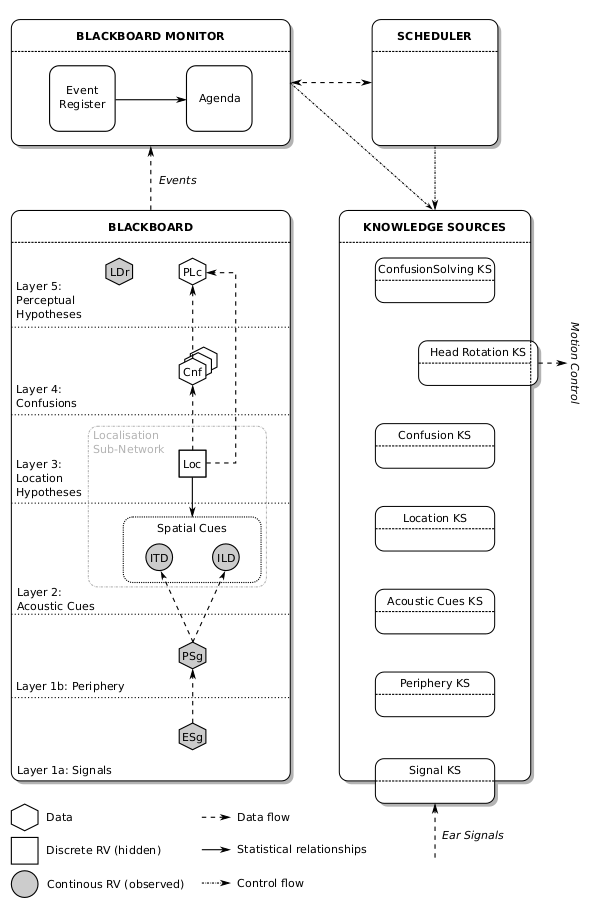Introduction
The goal of the Two!Ears project is to develop an intelligent, active
computational model of auditory perception and experience in a multi-modal
context. In order to do so, the system must be able to recognise acoustic
sources and optical objects, and achieve perceptual organisation of sound in the
same manner as human listeners do. Bregman has referred to the latter phenomenon
as ASA [Bregman1990], and to reproduce this ability in a machine system a
number of factors must be considered:
- ASA involves diverse sources of knowledge, including both primitive (innate)
grouping heuristics and schema-driven (learned) grouping principles.
- Solving the ASA problem requires the close interaction of top-down and
bottom-up processes through feedback loops.
- Auditory processing is flexible, adaptive, opportunistic and
context-dependent.
The characteristics of ASA are well-matched to those of blackboard
problem-solving architectures. A blackboard system consists of a group of
independent experts (knowledge sources) that
communicate by reading and writing data on a globally-accessible data structure
(blackboard). The blackboard is typically
divided into layers, corresponding to data, hypotheses and partial solutions at
different levels of abstraction. Given the contents of the blackboard, each
knowledge source indicates the actions that it would like to perform; these
actions are then coordinated by a scheduler, which determines the order in which
actions will be carried out.
Blackboard systems were introduced by [Erman1980] as an architecture for speech
understanding, in their Hearsay-II system. In the 1990s, a number of authors
described blackboard-based systems for machine hearing [Cooke1993],
[Lesser1995], [Ellis1996], [Godsmark1999]. All of these systems were in most
respects conventional blackboard architectures, in which the knowledge sources
employed rule-based heuristics. In contrast, the Two!Ears architecture aims to
exploit recent developments in machine learning, by combining the flexibility of
a blackboard architecture with powerful learning algorithms afforded by
probabilistic graphical models.
The general structure of the Blackboard system is shown in
Fig. 42. It consists of different knowledge
sources that can put data on and receive data from the blackboard. In addition,
special knowledge sources can perceive data from outside (ear signals) or
send data to the outside (turn the head). The management of the different
processes going on in the blackboard is achieved by monitoring and scheduling
which is performed by two independent modules.
Read on for further details on the blackboard architecture, details on the knowledge sources, or start with use the blackboard system.
| [Bregman1990] | Bregman, A. S. (1990), Auditory scene analysis: The perceptual organization
of sound, The MIT Press, Cambridge, MA, USA. |
| [Erman1980] | Erman, L. D., Hayes-Roth, F., Lesser, V. R., and Reddy, D. R. (1980), “The
Hearsay-II speech understanding system: integrating knowledge to resolve
uncertainty,” Computing Surveys 12(2), pp. 213–253. |
| [Cooke1993] | Cooke, M., Brown, G. J., Crawford, M., and Green, P. (1993), “Computational
auditory scene analysis: listening to several things at once,” Endeavour
17(4), pp. 186–190. |
| [Lesser1995] | Lesser, V. R., Nawab, S. H., and Klassner, F. I. (1995), “IPUS: An
architecture for the integrated processing and understanding of signals,”
Artificial Intelligence 77, pp. 129–171. |
| [Ellis1996] | Ellis, D. P. W. (1996), “Prediction-driven computational auditory scene
analysis,” PhD thesis, Massachusetts Institute of Technology. |
